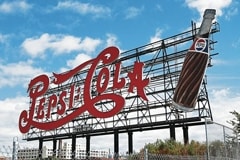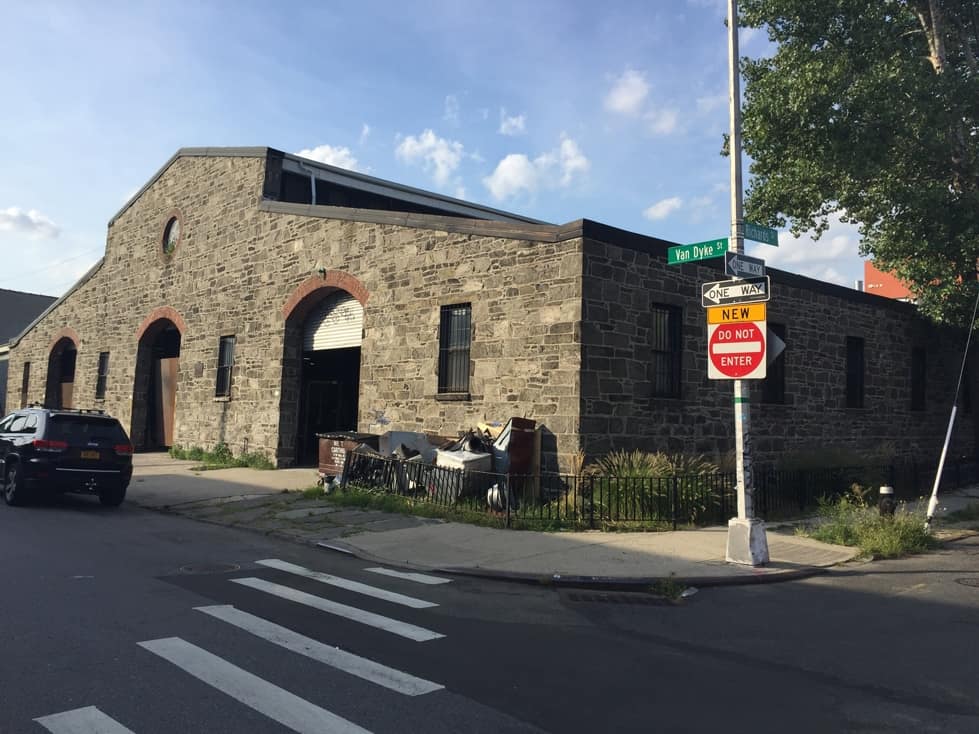In June, the Gowanus Landmarking Coalition, an advocacy group for historic preservation, earned a significant victory – albeit an incomplete one – when the Landmarks Preservation Commission (LPC) agreed to calendar five buildings in Gowanus. This decision increased the likelihood that, in the form of longstanding anchors like the American Can Factory and the Brooklyn Rapid Transit Powerhouse, some of the blue-collar history of one of Brooklyn’s most maligned and polluted neighborhoods would outlast a rezoning-spurred invasion of condos.
The announcement stirred interest in Red Hook, too, which in recent months has lost two of the most significant elements of its built environment: the Lidgerwood Building at 202 Coffey Street and the S.W. Bowne Grain Storehouse at 595 Smith Street. Only two buildings in the area – the circa-1859 Brooklyn Clay Retort and Fire Brick Works Storehouse at 76 Van Dyke Street and the WPA-constructed Red Hook Recreation Center at 155 Bay Street – bear the protection of landmark status, and some Red Hookers would like to see more.
As residents well know, Red Hook is not the Upper East Side. It’s a traditionally working-class neighborhood of maritime industry, and it doesn’t have mansions, cathedrals, or skyscrapers. Utilitarian structures can be beautiful, too, but they rarely catch the LPC’s eye, and over the years, changing industrial practices – which in turn tend to alter the buildings that house them – can compromise their claims to historic merit. Still, these buildings tell stories, and New York City’s distribution of landmarks (the majority of them in Manhattan) can bring to mind questions of equity – about whose stories and memories seem to matter, and which of the city’s denizens seem to have a right to the comforts of continuity and a recognizable sense of place within the churn of growth, decline, and redevelopment.
The LPC safeguards 150 historic districts and 1,431 individual landmarks in the five boroughs. Of those individual landmarks, residences make up the lion’s share. According to my own analysis, only 34 individual landmarks are industrial structures. That’s about two percent of the total.
The definition of “industrial” is to some degree subjective. For my list, I included factories, mills, refineries, and other sites of fabrication; warehouses; and certain types of public works and hard infrastructure, like sewage treatment plants and power stations – but not, for example, bridges, train stations, or garages. The goal was to isolate the constituent parts of the sometimes unadorned and often unnoticed network of steel and concrete that undergirds and facilitates modern life: the noisy, smelly machinery that makes things easy for all those who never have to come into contact with it.
My list consists of structures developed for industrial purposes, even if they now serve other ends or even had already undergone conversion by the time the LPC appraised them. Older buildings presented a challenge: before the 1916 Zoning Resolution, New York didn’t segregate land uses, and in the old days, merchants usually co-located their warehouse and retail operations. Manhattan holds a number of landmarked store-and-loft buildings, many of which contained offices, storage, sales, and light manufacturing all at the same time. The LPC classifies these structures as “commercial,” but some (especially those that primarily accommodated small factories) made the cut here, while others didn’t, depending on the dominant historical use per the LPC’s designation report.
18 of New York’s industrial landmarks are in Manhattan: the IRT Powerhouse, the Excelsior Steam Power Building, 41 Worth Street, the F.W. Devoe & Company Factory, the Wheatsworth Bakery, the Brown Building, the Avildsen Building, two Croton Aqueduct gatehouses, the Joseph Loth & Company Silk Ribbon Mill, the Starrett-Lehigh Building, the Robbins & Appleton Building, the Fleming Smith Warehouse, the Municipal Asphalt Plant, the DeVinne Press Building, 193 Front Street, 191 Front Street, and the High Bridge Water Tower. This collection includes a former watchcase manufacturer, an old freight terminal, and the site of the infamous Triangle Shirtwaist Factory fire.
 Five industrial landmarks (the Estey Piano Company Factory, the American Bank Note Company Printing Plant, the Bronx Grit Chamber, and the High Pumping Station) belong to the Bronx. Two (the Sohmer & Company Piano Factory and the Pepsi-Cola sign from Long Island City’s demolished bottling plant) lay in Queens. There’s just one (a remainder of the Standard Varnish Works factory complex) on Staten Island.
Five industrial landmarks (the Estey Piano Company Factory, the American Bank Note Company Printing Plant, the Bronx Grit Chamber, and the High Pumping Station) belong to the Bronx. Two (the Sohmer & Company Piano Factory and the Pepsi-Cola sign from Long Island City’s demolished bottling plant) lay in Queens. There’s just one (a remainder of the Standard Varnish Works factory complex) on Staten Island.
With eight industrial landmarks, Brooklyn has received better treatment than the other outer boroughs. The Kings County notables are the Empire State Dairy Company Buildings, the M.H. Renken Dairy Company Buildings, the William Ulmer Brewery, the Domino Sugar Refinery, the Hecla Iron Works, the Thomson Meter Company Building, the aforementioned Brooklyn Clay Retort and Fire Brick Works Storehouse, and Dry Dock #1 at the Brooklyn Navy Yard.
Brooklyn’s most recent industrial landmark, the Empire State Dairy Company Buildings at 2840 Atlantic Avenue in East New York, is an instructive case. In 2016, the Department of City Planning (DCP) authored the East New York Neighborhood Plan, a comprehensive rezoning intended to increase density and create housing. City Council approved the plan in April, and three months later, the LPC held a public hearing for the Empire State Dairy. The landmarking secured six interconnected structures between Schenck Avenue and Barbey Street, but it left undefended the southern portion of the lot, where a developer now plans to demolish two associated buildings to make way for a 14-story residential tower.
Occasionally regarded as a possible lifeline for communities under threat by private interests, the LPC does not, however, operate independent of the politics that in many cases enable those interests. Mayor Robert F. Wagner Jr. created the agency in 1965 with a mandate to watch over structures of architectural, historic, and cultural significance, and ideally, perhaps, the LPC would make its rulings on these grounds only.
Of course, from an urban planning perspective, it would be irresponsible not to weigh the opportunity cost when considering giving over permanently a piece of city land to one particular building, which, if its usefulness has expired, might interfere with desired growth or renewal in the area. But the City Charter delegates the pragmatic questions to the City Planning Commission (CPC), which must compile a report regarding possible impacts on development following an LPC designation, and to City Council, which subsequently must evaluate these impacts and then vote to approve or reject the designation. (The mayor also has a veto option.)
In the real world, however, City Council very rarely votes against an LPC designation, and the mayor has never had to shoot one down. Councilmembers prefer not to be put into a position where they’d have to reject a new landmark publicly. Instead, the LPC coordinates with City Council, the DCP, the CPC, and the Mayor’s Office on the front end. The 11 mayor-appointed commissioners generally won’t designate or even calendar a potential landmark unless the other city agencies and the elected officials are on board, and this approach covertly incorporates planning priorities into the LPC’s ostensibly aesthetic or scholarly assessment.
The most important elected official is the local councilmember – who, in some districts, may be hostile even to concept of historic landmarks, regarding them as an encroachment on property rights. As a result, some parts of the city (particularly in Queens and Staten Island) have few or no landmarks, but it’s not necessarily because the architects and historians of the LPC don’t believe that any of the buildings there have merit.
In other words, the LPC did not, in June, forcibly wrench a portion of Gowanus from Bill de Blasio, Brad Lander, or the DCP’s Gowanus Framework. Instead, it worked with other parts of city government to determine which buildings could be spared from demolition without compromising the larger aims of the rezoning. The LPC has no power to overturn development goals.
Whichever buildings in Gowanus ultimately earn landmark status, they’ll surely deserve it on architectural and historic grounds, but the designations will serve first as a political maneuver. As community givebacks in exchange for a host of other possibly unappealing changes, they will, if all goes well for the city, offer just enough local stability to appease residents. (Soon after the Greenpoint-Williamsburg rezoning of 2005, the LPC landmarked the Williamsburg Bridge-adjacent Domino Sugar Refinery – whose exterior, as a decorative ruin, will soon enclose a new glass office tower – but the surrounding neighborhood nevertheless became unrecognizable.)
Whether Red Hook can garner LPC attention without accepting a total overhaul by DCP first remains to be seen. The LPC is an underfunded, understaffed agency, and bringing buildings to the top of its pile – no easy feat – tends to require serious activism by groups like the Historic Districts Council. An element of danger (that is, an imminent possibility of demolition or serious alteration of a significant building) can jumpstart the LPC, but only if the politicians haven’t specifically created or endorsed that danger.
Red Hook’s councilman, Carlos Menchaca, has spoken in favor of landmarking. But historic preservation here wouldn’t come cheap: the potential cost of landmarking a massive disused warehouse that might otherwise become a last-mile distribution center for Amazon vastly exceeds that of landmarking a fancy Manhattan townhouse in a row of other fancy townhouses for the purpose of preventing a homeowner from making any tacky renovations.
Beyond issues of taste and familiarity, this partly explains the dearth of industrial landmarks in postindustrial New York: while the city’s old houses still have people in them, many of its factories don’t, and one doesn’t necessarily want to deprive an abandoned factory of the chance to become something new. Adaptive reuse is possible, but it’s relatively expensive, and in some cases a mandate against demolition could discourage new investment in the property.
If Red Hook wants to see new landmarks in the neighborhood, the community would likely have to rally together to make them happen. As it is, different residents have different priorities. NYCHA problems take up most of the time of Red Hook Houses tenants. In the Back, some hope to see residential growth, while others want to retain and reinvigorate Red Hook’s manufacturing. And then there are those who’d mostly just like things to stay the way they are.
All four groups are bound to have different views not only of the value of preserving Red Hook’s industrial heritage but of the meaning of such an endeavor. Is it about holding onto the buildings that serve as monuments to industry of the past, or is it about keeping blue-collar jobs on the waterfront? Historic preservation of industrial buildings is mostly unrelated to the preservation of living industry, except when it actually presents an obstacle to the introduction of new industry by embalming the unusable industrial infrastructure of an earlier era. This isn’t always the case, but by my count, only seven of the 34 industrial landmarks in New York remain in use by industrial tenants. An old mill or historic warehouse may lend itself more easily to residences or offices.
For proof, one can look to the landmarked DUMBO Historic District – or to the foot of Van Brunt Street, where the Fairway supermarket shares the former Red Hook Stores with upper-level apartments. Alongside the Merchant Stores and the Beard and Robinson Stores, the Red Hook Stores belong to a beautiful complex of waterfront warehouses owned by the O’Connell Organization, where artists and artisans maintain studios next to the Red Hook Winery and the office of the Star-Revue. The area remains not only attractive but vibrant, and it’s hard to imagine any real need to tear it down. The LPC may notice it someday.









